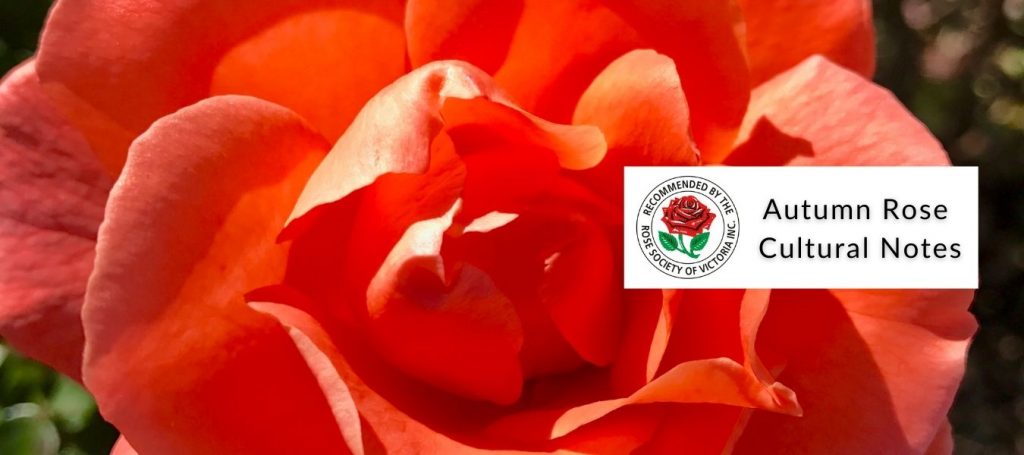
AUTUMN ROSE CULTURE NOTES FOR VICTORIA
Rose Society of Victoria, written by Dr. Jacinta Burke
Now is the time to be enjoying the autumn flush of blooms. It is also the time to be thinking about next season’s blooms and to assess how your plants have been performing over the last few seasons. The nurseries have new offerings for planting this winter. It is wise to order early as many popular varieties sell out early.
Many of us have limited space for growing our roses. It does not make good sense to keep an underperforming rose when a better variety could be grown in its place. Before discarding a variety, look at the conditions under which it is growing. It may be that the variety is growing in the wrong place. Is there a tree or large shrub nearby which may have roots invading the area and therefore competing for nutrients and water? Is the rose growing in too much shade? While roses will grow on the south side of the house they rarely perform at their best. Is the rose getting sufficient air movement? If the rose is crowded out by other plants it may not get sufficient air movement to reduce the risk of getting fungal diseases.
Before discarding a rose, it may be best to try it in a more suitable location or grow it in a pot. If it still does not perform, then it is time to get rid of it. Not all roses are good performers. Indeed, over time many roses have been discarded by nurseries for this very reason.
Preparing for New Roses
Now is the time to remove any roses that you are discarding. If you are planning to plant roses back into the same locations the soil will need preparation. It is best to remove about a wheelbarrow-full of soil from each site where the roses were previously. The soil is then replaced with soil from elsewhere in the garden where roses have not been growing for at least a few years. If you do not do this there is a risk that your new roses will develop a condition known as Rose-Sick disease. The new roses will fail to thrive. The reasons for this are not really understood but one theory is that nematodes may be present in the soil in high numbers and these attack the roots preventing proper development of the roses. Once the new soil is in place dig it over incorporating some of Neutrog’s Meatworks – Blood & Bone. Also water in GOGO Juice to add beneficial bacteria and fungi to the soil. Dig the area over a few times again before planting your roses.
If removing a wheelbarrow-full of soil is beyond your capability, you can plant each new rose in a 40 cm cardboard box. Make sure that you remove any traces of roots from the previous rose and then dig a hole large enough accommodate the cardboard box. The box can then be put into the hole at planting time and then a mixture of fresh soil from another part of the garden and potting mix can be used in the cardboard box. Over time the new rose will develop a strong root system which will grow out into the surrounding soil when the box decomposes.
Planting New Roses
If you have ordered bare-root roses, unpack them as soon as they arrive. Completely submerge the roots in a seaweed solution such as Seamungus Liquid for 24 – 48 hours. Your plants will then be ready to put in their prepared sites. If your roses arrive before you have your sites ready, you can heel in the plants in a convenient location e. g. a spare bit of ground in the vegetable patch. To do this, dig a trench deep enough to completely accommodate the roots of the roses. Place your roses in the trench and completely cover the roots with soil. Water in well with a diluted seaweed solution. The bare-root roses can stay there until you are ready to plant them in their permanent locations.
Once you are ready to plant your bare-root roses take them in a bucket of water to the planting sites. It is important not to allow the roots to become dry as this can lead to the plants not establishing. Dig a hole deep enough to accommodate the roots, generally about 30 cm wide and deep, allow for the graft to be about 2.5 cm above the soil. Incorporate some Seamungus pellets into the soil at the bottom of the hole. Make a mound in the centre at the bottom of the hole. Check the roots to ensure that they are not damaged. Remove any damaged portions by pruning with clean, sharp secateurs. Place the base of your rose onto the mound in the hole spreading the roots around on the mound. Ensure that all roots are pointing downwards to prevent the roots forming suckers. Backfill the hole to about the halfway point and firm the soil down. Fill the hole with water and allow to drain away. Finish filling the hole with soil ensuring that the graft is 2.5 cm above the level of the soil. Again, firm the soil down around the base of the plant. Finally, water the rose in with a Seamungus Liquid solution. Trim the rose back to about 20 cm above the graft making sure that you cut about 1 cm above a growth eye on each stem.
Planting of roses from pots can be done at any time of the year. Prepare your soil well ahead of time as detailed before. Dig a hole more than large enough to accommodate the size of the pot. Knock the plant out of the pot and check the roots. If the roots are circling around the root ball it is best to cut the roots and tease them out. Place the plant’s roots into the hole ensuring that the graft is 2.5 cm above the surrounding soil. Backfill with soil and firm down around the base of the rose. Water in with at least half a bucket of seaweed solution made with Seamungus Liquid. Prune the rose lightly. Once planted mulch with Whoflungdung.
Autumn Maintenance
Continue to deadhead your roses to keep them tidy. The roses are unlikely to produce new shoots now, any that do form beyond May, are unlikely to produce any flowers. The plants are preparing to go into their winter dormancy. Spraying for Black Spot, Powdery Mildew and Rust with Eco Rose or Eco Fungicide can continue in April and May but discontinued in June.
May is the best time for spreading dolomite lime. This will help overcome the build-up of acidity due to the use of fertilisers. The magnesium in dolomite is also useful for forming chlorophyll in the leaves and therefore benefits plant growth.
Propagation
May is a good time for taking cuttings for understocks or indeed any variety that you wish to propagate. In Victoria, Rosa multiflora is generally used for understock, although some nurseries use ‘Dr Huey’. Cuttings for understocks for bush roses should be 20 – 25 cm long and taken from a cane that has flowered. Remove all but the two uppermost eyes. Do not use cuttings that have a heel as this can lead to suckering from the stock. Wrap the cuttings in bundles in damp newspaper and put into a plastic bag. The wrapped cuttings can then be placed in a cool shady place to callus for about six weeks. After this time the cuttings can be placed into propagating mix in a pot or put into unfertilised well-drained soil. Water well after planting the cuttings.
Many varieties do well on their own roots. Plants propagated on their own roots have the advantage that they do not have suckers coming from a rootstock. All new shoots coming from the base of the plant can be kept. Not all varieties do well on their own roots and others do better on their own roots. A lot has to do with the soil. Be prepared to experiment and see what works for you. Plants taken by cuttings take about a year to catch up to plants that have been budded. However once established a plant grown from cuttings will usually be as good as a plant grown from budding. Cuttings should be taken from a stem that has flowered. They should be about 20 – 25 cm long and it is not necessary to remove any of the growth eyes. They can be grown in propagating mix in a pot or put into unfertilised well-drained soil.
May is a good time to plant out in a permanent position any roses that were propagated from cuttings last year. It is important to prepare the permanent site at least a month before. If you are digging up the plants from your propagating bed, make sure that you check the roots for any damage. Any damaged roots should be trimmed with sharp secateurs. It will also be necessary to do a winter prune on the top of the plant to compensate for the loss of roots.
Contact the Rose Society of Victoria – website https://rosesocietyvic.org.au for more information.

